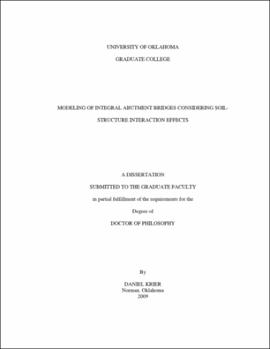| dc.contributor.advisor | Muraleetharan, Kanthasamy K||Mish, Kyran D | |
| dc.creator | Krier, Daniel | |
| dc.date.accessioned | 2019-04-27T21:25:22Z | |
| dc.date.available | 2019-04-27T21:25:22Z | |
| dc.date.issued | 2009 | |
| dc.identifier | 9917536302042 | |
| dc.identifier.uri | https://hdl.handle.net/11244/318638 | |
| dc.description.abstract | Soil-structure interaction problems are both highly interesting and highly complex. To model soil-structure interaction problems accurately, the constitutive parts (i.e. foundations, soils, and superstructures) must be considered. Implementing the finite element technology necessary to analyze soil-structure interactions problems is a significant task. In this work, structural elements were added to the soil analysis computer program TeraDysac (Muraleetharan et al. 2003, Ravichandran 2005) and the soil-structure interaction in integral abutment bridges (IABs) was studied. IABs are a form of bridge where the superstructure ends are cast integrally with the abutments. The abutments, which are supported on piles in weak-axis bending move into and away from the backfill soils when the bridge deck undergoes thermal loading. These bridges provide numerous advantages to traditional bridges including reduced maintenance, simpler bridge hardware, and better water-tightness. However, because the superstructure movement is not accommodated with rollers or bearing pads like in traditional bridges, a complex soil-structure interaction problem emerges. | |
| dc.description.abstract | Three-dimensional (3D) Timoshenko beam elements and Reissner-Mindlin plate elements were developed. The merging of soil and structural elements allows bridge models to be developed that consider all of the components of an actual bridge in a realistic manner. In addition to the structural elements, a thermal loading scheme and a nonlinear beam bending stiffness (EI) scheme were also developed. In IABs, the abutment piles sometimes yield and hence enter a nonlinear range, so a nonlinear EI application may be important. Both linear elastic and bounding surface soil models were considered in this work to model the stress-strain behavior of soils. | |
| dc.description.abstract | Several soil-structure interaction problems were analyzed in this work. Beams on elastic foundations were studied and comparisons were made between analytical results and the solutions obtained from a TeraDysac finite element analysis. A nonlinear soil-structure interaction analysis using TeraDysac with a bounding surface clay model is compared with results obtained from LPILE (ENSOFT 2007), which uses a p-y approach. | |
| dc.description.abstract | To test and validate the developed finite element technology, results from the field instrumentation of an IAB in Minnesota were used (see Huang et al. 2004). Two thermal events were studied in this work, a heating event during the summer and a temperature drop during the winter. The IAB used for the validation has a zero skew angle. A series of two-dimensional (2D) analyses were used to study the bridge behavior. A method for obtaining the approximate 2D structural properties is discussed. A 3D analysis comparing the Minnesota IAB superstructure (no skew) and a skewed version of the same superstructure is presented. A non-uniform abutment movement and stress distribution in the backfill soils in the skewed example show the importance of a 3D analysis when IABs are skewed. | |
| dc.description.abstract | The reinforced concrete behavior at the bridge site was studied in detail using the finite element program TeraGrande (ANATECH 2005). TeraGrande models the rebar accurately and uses a smeared crack concrete model. Significant nonlinear behavior (e.g. cracking) was not seen for the thermally-induced abutment movements. Therefore, the developed linear structural elements were deemed acceptable for the IAB analyses performed in this work. | |
| dc.format.extent | 201 pages | |
| dc.format.medium | application.pdf | |
| dc.language | en_US | |
| dc.relation.requires | Adobe Acrobat Reader | |
| dc.subject | Soil-structure interaction | |
| dc.subject | Bridges--Design and construction | |
| dc.subject | Soils--Analysis | |
| dc.subject | Bridges--Abutments | |
| dc.title | Modeling of Integral Abutment Bridges Considering Soil-Structure Interaction Effects | |
| dc.type | text | |
| dc.type | document | |
| dc.thesis.degree | Ph.D. | |
| ou.group | College of Engineering::School of Civil Engineering and Environmental Science | |
